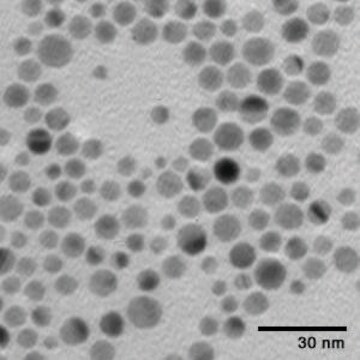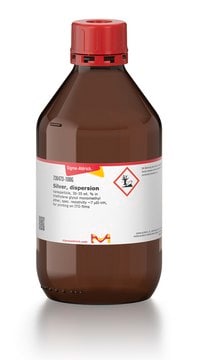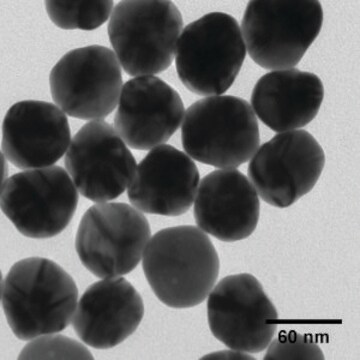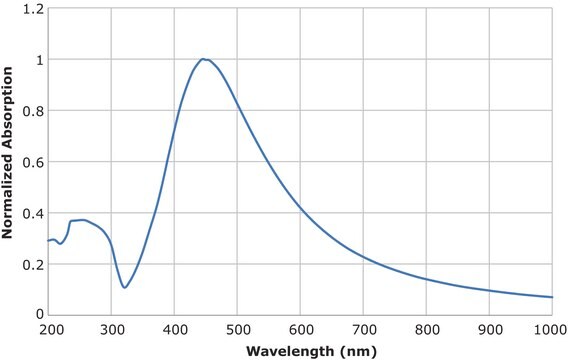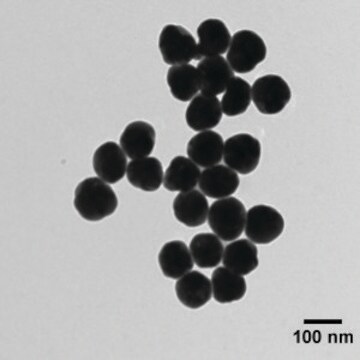736465
Silver, dispersion
nanoparticle, 30-35 wt. % in triethylene glycol monoethyl ether, spec. resistivity 11 μΩ-cm, for printing on plastic films
Synonyme(s) :
Silverjet DGP-40LT-15C, silver ink
About This Item
Produits recommandés
Niveau de qualité
Description
surface tension 35 - 40 dyn/cm
Forme
dispersion
nanoparticle
Concentration
30-35 wt. % in triethylene glycol monoethyl ether
Indice de réfraction
n20/D 1.333
Taille des particules
≤50 nm
Viscosité
10-18 cP
Densité
1.45 g/mL±0.05 g/mL at 25 °C
Température de stockage
2-8°C
Chaîne SMILES
[Ag]
InChI
1S/Ag
Clé InChI
BQCADISMDOOEFD-UHFFFAOYSA-N
Vous recherchez des produits similaires ? Visite Guide de comparaison des produits
Catégories apparentées
Description générale
Curing Temperature: 100-150 °C
Recommended substrates: Plastic films
Recommended washing solvent: Polar Solvents: Ethyl Alcohol, IPA etc.
Application
- Enhanced Adsorption of Trace Ethylene on Ag/NZ5 Modified with Ammonia: Hierarchical Structure and Metal Dispersion Effects.: This study examines the effects of hierarchical structure and metal dispersion in enhancing the adsorption of trace ethylene using silver/nanozeolite 5 modified with ammonia, exploring potential industrial applications for improved air quality and storage conditions (Qi et al., 2024).
- Structure-Activity Relationships between the State of Silver on Different Supports and Their I(2) and CH(3)I Adsorption Properties.: The paper details the correlation between the physical state of silver dispersed on various supports and its properties in adsorbing iodine and methyl iodide, which could be crucial for developing better filtration and purification systems (Azambre et al., 2021).
- New Relevant Descriptor of Linear QNAR Models for Toxicity Assessment of Silver Nanoparticles.: This publication introduces a new quantitative nanostructure-activity relationship (QNAR) descriptor that enhances the toxicity assessment of silver nanoparticles, significant for pharmaceutical applications where safety is paramount (Kudrinskiy et al., 2020).
- Resolving the puzzle of single-atom silver dispersion on nanosized γ-Al(2)O(3) surface for high catalytic performance.: Investigates the single-atom dispersion of silver on nano-sized γ-alumina surfaces, providing insights into optimizing the catalytic efficiency and potential applications in various chemical industries (Wang et al., 2020).
Remarque sur l'analyse
Informations légales
Mention d'avertissement
Warning
Mentions de danger
Conseils de prudence
Classification des risques
Aquatic Acute 1 - Aquatic Chronic 1
Code de la classe de stockage
10 - Combustible liquids
Classe de danger pour l'eau (WGK)
WGK 3
Point d'éclair (°F)
Not applicable
Point d'éclair (°C)
Not applicable
Faites votre choix parmi les versions les plus récentes :
Déjà en possession de ce produit ?
Retrouvez la documentation relative aux produits que vous avez récemment achetés dans la Bibliothèque de documents.
Les clients ont également consulté
Articles
Inkjet Printing for Printed Electronics
The emerging field of printed electronics requires a suite of functional materials for applications including flexible and large-area displays, radio frequency identification tags, portable energy harvesting and storage, biomedical and environmental sensor arrays,5,6 and logic circuits.
The ability to pattern conductive electrodes is technologically relevant for several applications, including photovolatics, displays, sensors, and biomedical devices.
Recent progress in the area of solution-processed functional materials has led to the development of a variety of thin-film optoelectronic devices with significant promise in the industrial and consumer electronics fields.
Global Trade Item Number
| Référence | GTIN |
|---|---|
| 736465-100G | 4061832875200 |
| 736465-25G | 4061832875217 |
Notre équipe de scientifiques dispose d'une expérience dans tous les secteurs de la recherche, notamment en sciences de la vie, science des matériaux, synthèse chimique, chromatographie, analyse et dans de nombreux autres domaines..
Contacter notre Service technique